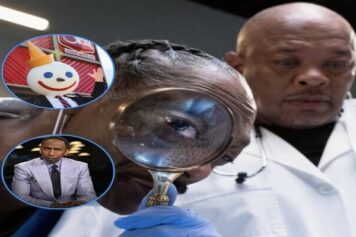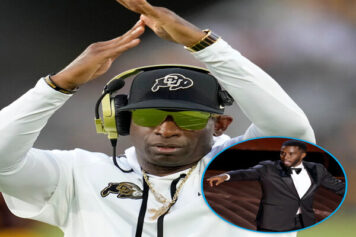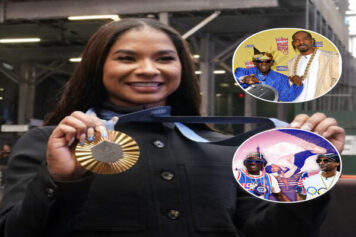As the '80s wrapped and hip hop became less of a novelty to mainstream America, hip hop artists raised the stakes. The music globalized into cultures worldwide and the underlying conscious tone of '80s hip hop transformed into what became known as “Gangsta Rap.”
The first gangsta rap album to captivate a huge audience, selling more than 2.5 million copies, was N.W.A.'s Straight Outta Compton (1988).
I remember as a 14-year-old having to trick my parents into buying me the album for Christmas. They had no idea how vulgar, edgy, liberating and mind-warping that album was to a young, impressionable kid from Queens, NY. On top of that, the beats and lyrics were incredible. I remember their faces when I opened the gift and popped it in the stereo cassette player. They looked mortified and bamboozled at the same time. But my joyous expression lightened their strict parental spirits, so they let me rock.
N.W.A.'s controversial subject matter, including drugs, violence and sex, helped popularize what became known as 1990’s “gangsta rap” (said to have begun with Ice-T's "6N' Da Morning").
Specifically, the song "Fuck tha Police" drew the ire and eye of law enforcement. It also earned them the reputation of gangbanging rebel rousers. They became idolized by every pre-college kid who was either harassed by the cops, saw their communities and parents disrespected by police, or had their entire lives turned upside down because of encounters with law enforcement.
Despite the rising plethora of West Coast artists and groups to emerge in the '90s (from Souls of Mischief to D.J. Quick) no West Coast hip hop group put Cali on the map like NWA, whose musical prowess and intense, frustrated and fearless delivery prompted a strongly-worded letter of discontent from the FBI.
Down South, Luke Skywalker was flipping wigs in Florida. He had The Broward County Sheriff’s Department on his ass and every chick popping her coochie and booty. Consequently, he also drew increased criticism and government attention for the sexually explicit lyrics in his songs and the scantily–clad, stripper-type dancers that performed at his shows.
Those two incidents legitimized hip hop as a musical genre that wasn’t a “fad,” as some had suggested in the early '80s. It was exploding into the mainstream, touching its share of white ears, and now recognized as a true potential tool of upliftment or destruction for young people. Either way, it was a threat to the powers that be. But there was nothing anyone could do to temper its growth. The NY rap scene had its share of gangsta rappers too. Groups such as Black Moon fused the gritty "backpack rap" and gangsta rap styles. Mobb Deep is one of the longest-standing legends of East Coast gangsta rap.
While politicians and other tight asses made it their American crusade to get ratings on albums and music banned, the art form internationally was spreading to every corner of the globe from Germany, to Asia and South Africa.
With the '90s in full swing, hip hop and its elements of breakdancing, graffiti and DJ’ing became an arts movement with the ability to create something dope and new by using technology, spoken word, and artistic dance and motion. It could also now broadcast to the world with the emergence of cable video shows such as Yo! MTV Raps and BET’s rap and R&B programming. The genre was also featured throughout cult-classic gangsta flicks such as Boyz n the Hood, Menace II Society, Blood In Blood Out, New Jack City and Sugar Hill.
Once NWA set the gangsta movement off, rap became more mainstream. In 1992, with the release of Dr. Dre's The Chronic, the album established a style called G Funk, which soon came to dominate West Coast hip hop. It almost singlehandedly reinvigorated the marijuana craze that has permeated today’s society and become a staple of rap music content.
I remember being a college freshman at Hampton University the year The Chronic dropped. On Monday, the campus was drug free. But when Snoop, Dre, and The Dog Pound crashed the scene telling heads to "spark one," by Tuesday the campus had turned into a Cheech and Chong fest. The Chronic is probably the most influential album of the '90s.
Meantime, Apache’s "Gangsta Bitch" was influential along the east coast, lauded for its high sales. Its lasting impact came in revealing the female side of gangster life and the down-ass chicks that were undervalued and overlooked in thug and gang life. "Gangsta Bitch" gave less-prissy chicks a place in the new hip hop movement.
But those most influenced by this new style of music were middle class, suburban minorities and Caucasians who didn’t come in contact with any of the violence, pain and persecution painted in the revealing poetry of gangsta hip hop artists. On Hampton’s campus, for instance, I saw girls transform from church-going, conservative teens to tough-talking, multi-colored bandana-rockin, low sweat pants-wearing, jail shirt-flossing, lumberjack shirt-repping gangsta chicks.
It was a philosophy that began to engulf the generation, playing right into the Bush-led Republican party’s hands. The music led to an increase in crime, drug activity, violence and college careers coming to abrupt halts because momma’s pre-med student also dabbled in coke, crack sales, and brandishing arsenals of easily obtained assault weapons.
It was a plan that went back to the '80s, when in 1986, the Reagan Administration passed a law requiring federal judges to give fixed sentences to drug offenders based on variables including the amount seized and the presence of firearms. The broadening of The Rockefeller Drug Laws and other tough drug-related penalties, with heavy mandatory sentences, crippled families and destroyed communities, compounding the already debilitating effects of the' 80s "Crack Era."
The '90s were a reflection of this, giving rise to a generation of crack babies and packed jail cells.
Though West Coast artists eclipsed those from New York in terms of record sales, New York based artists who maintained that harder edged, street sound still had an impact on hip hop’s developing toughened culture.
Lyrically supreme dudes like Nas (Illmatic) and super groups such as Wu-Tang Clan, generally had mediocre or sporadic sales compared to the hip hop music that was emerging, but still had ridiculous world-wide followings. Guys like Jay-Z began to rise and forge musical empires built on dope dealing and studying previous legends, while fusing credible gangsta-rap with hip-pop. Playing a delicate balancing act, socially aware and positive hip-hop gained in legacy as the '90s progressed. The moderate mainstream success of groups that managed to overlap from the '80s, such as De La Soul and A Tribe Called Quest, led to Gang Starr, Mos Def, Talib Kweli, The Fugees, and The Roots. They all helped prove that hip- hop had become the most diverse form of music in the world.
The 90's was the last era to respect or enforce a “street code.” Snitches still got stitches, instead of a pat on the back. The Bloods & Crips and certain ruthless Latino gangs — with the help of a massive incarceration of minorities throughout the country — were beginning to permeate the culture, spreading into and setting up sects in New York – a region that notoriously repelled the acceptance of large-scale “outside” gangs. NY originally chose to maintain its many clicks based on neighborhood affiliation.
Gangs grew to epidemic proportions. They possessed a stronghold on communities and threatened such intense violence that Drug Cartels on high and low scales began entrusting gangs with serious responsibilities in the booming international drug trade.
Back on the music side, artists like Tupac Shakur would start his rapping career in 1991. He dominated ‘90s music with his “thug life content.” He kept close gang-affiliations and began to put it down on the big screen, as rap artists started becoming more prominently featured in movies and TV. Before being shot and killed in a drive-by in 1996, Tupac was on his way to becoming the highest selling rapper ever with over 75,000,000 albums sold worldwide.
Mirroring the West, Brooklyn’s Notorious B.I.G. rose to fame around the same time as Tupac. Being from New York, Biggie brought the East Coast back into the mainstream at a time when the West Coast had rap on smash. Both legends played a huge role (some might say as pawns) in the ugly feud that pitted Puff Daddy’s machine-gun funk Bad Boy click against Suge Knight’s intimidating Death Row Records artists.
The sales rivalry between the East Coast and the West Coast eventually turned into personal beef, aided in part by the media. Countless reporters were not aware that MC battles were an integral part of hip hop since its inception. And that generally, little was meant by open taunts on albums and in performances. That ignorance towards hip-hop culture led to the media adding flames to rivalries that initially only existed on wax. During this East Coast-West Coast beef – similar to the effects of actual war – the two sides basically killed each other off – its kings included with the murdered lives of Tupac and BIG – wasting time beefing instead of collaborating and maintaining its stronghold on the music industry.
In the process, record labels based out of Atlanta, St. Louis, Texas and New Orleans came up and gained acclaim for their local scenes. Artists such as Master P, Outkast and a host of other Southern cats became hip hop icons that turned the attention away from New York rap which was becoming played out. The Midwest rap scene also had major achievements with mega-artists emerging like Nelly and unique fast rapping styles from Twista to Cleveland’s Bone Thugs-n-Harmony (Discovered by NWA founder Easy-E).
The '90s diversified and spread hip hop culture so much that it also marked the end of hip hop as a culturally uplifting art form owned and operated by black people. They may have initially owned it, but by the end of the decade — with the emergence of a white, blond-haired rapper named Eminem, who rode a cosign by Dr. Dre all the way to rap immortality and unfathomable fame – it was clear that rap music was a fusion of all faces and no longer the ownership of one race.
Em’ was known for his controversial lyrics beginning in 1999 with his second studio album The Slim Shady LP. He arrived a decade after Vanilla Ice became the first white rapper to blaze the charts with Ice Ice Baby in 1989. The difference in the '90s was that the world was ready for Em. And he could spit it as good as any black dude without being seen as the embarrassing, insulting gimmick Vanilla Ice was.
Eminem's emergence marked the end of '90s hip hop. When he graced the cover of Rolling Stone that ushered in millennium hip hop. The gangsta rap era had officially morphed into the era of extreme commercialization. Fewer rappers outside of the Tribe Called Quests, Mos Defs, and Talib Kwelis of the world, spit about social issues such as homelessness, education, drugs, and AIDS prevention.
Simultaneously, the 1990’s gave way to rapcore (a fusion of hip hop and heavy metal). Becoming popular among mainstream audiences, Rage Against the Machine, Linkin Park, and Limp Bizkit were among the most hitting rapcore bands and anything else from Seattle's emerging Grunge to techno.
Some call it natural progression. Some call it the exploitation of a culture. Either way, the '90s marked the moment hip hop went from moderately popular dude to the QB of the football team.
New, original artists were still emerging, setting standards and being innovative. But in the year 2000, The Marshall Mathers LP by Eminem sold over ten million copies in the United States, and Nelly's debut LP, Country Grammar, sold over six million copies.
It was all because of the '90s where a recipe for unimaginable wealth was established for hip hop artists. And the music officially went from becoming a trendsetting cultural force to a watered-down, processed package, designed to chase the almighty dollar.
Damn, I miss the '90s.



